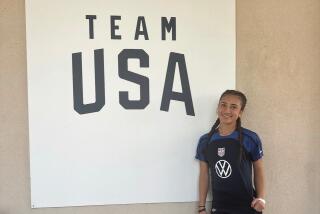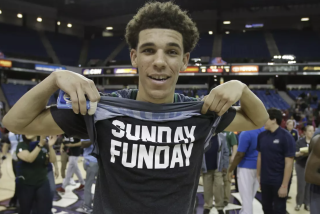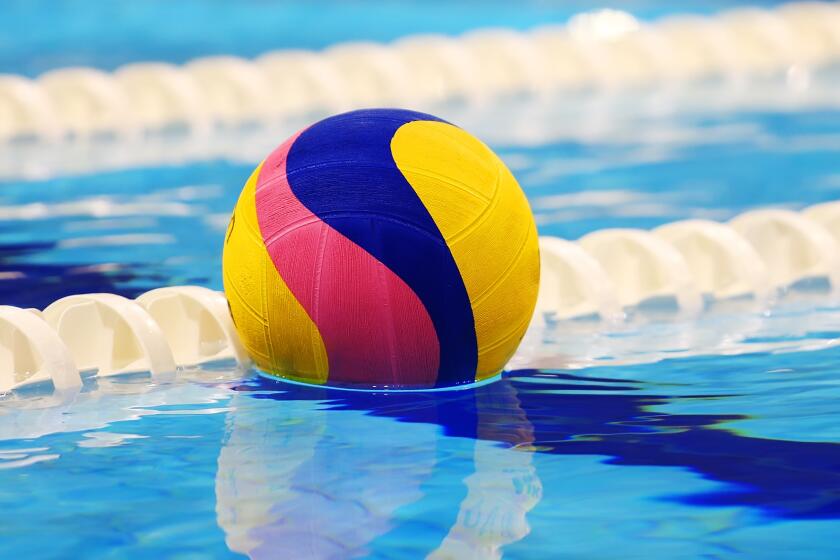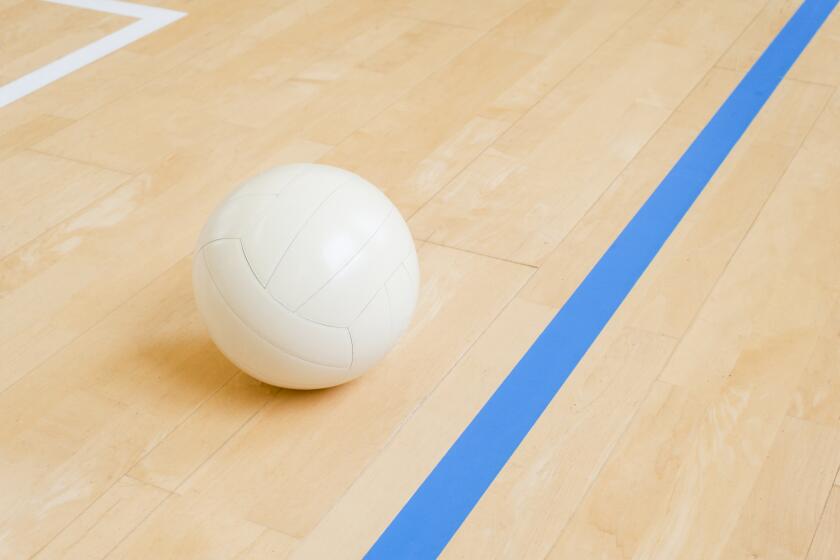Humble Pi
The only two Caltech fans in the gym are stomping loudly on the bleachers.
The only organized Caltech cheering section -- its benchwarmers -- is chanting, “Dee-fense, dee-fense.”
There are about two minutes remaining in a game against La Verne, and you can feel it, from the bottom of your sinusoid to the top of your parabola, history, legend, miracle, an actual Caltech victory.
The Beavers trail by only five points. They have the ball. They have the momentum. They have the embarrassment-fearing Leopards scared to death.
“Take it, take it!” Caltech Coach Roy Dow shouts.
And then they give it.
Bad pass. Charging foul. Lost dribble. Airball. Dream dead.
In the faces of the sweating, skinny Caltech kids, the beam of excitement is replaced by the dullness of familiarity.
As they trudge off the emptying court, the 70-56 flop to La Verne feels less like a loss than a birthright.
The Beavers have not won an NCAA game in 13 years -- they have 190 consecutive NCAA defeats.
They have not won a Southern California Intercollegiate Athletic Conference game in 21 years -- that’s 237 consecutive conference loss.
It doesn’t take a team of math geniuses -- which, um, they are -- to figure out what this means.
“The probability of us winning a game is barely detectable, it involves many variables, it’s very small but it’s there,” says Yang Hai, a sophomore guard. “We do have a mathematical chance of winning. But it has to fall into the chaos theory.”
Caltech’s roster has only six players who had high school varsity basketball experience and eight who were high school valedictorians.
“I hear these kids discussing their classes, and I have no idea what they’re talking about,” Dow says.
Caltech has only four players who can dunk the ball, but three seniors who already have prestigious full-time jobs after graduation, including two on Wall Street.
“The games are heartbreaking,” says guard Day Ivy, who averages four points, four rebounds and one future, as a foreign exchange derivatives trader for Deutsche Bank. “But we get closer and closer, and we never quit thinking we can win one.”
Such has been the energetic Dow’s mantra since he took over the team four seasons ago. Get closer. Believe you can win. And get some sleep.
Dow may be the only college basketball coach in America whose players are sometimes prohibited from playing because they study too much.
“I’ll see them walking into the gym for practice after pulling an all-nighter, and what can I do?” he says. “I send them home, because you can’t play when you’re exhausted.”
He is also, incidentally, the only coach in America who recruits against nuclear physicists.
“I’m talking to a kid about spending the summer working on his defensive stances, and he tells me he has to go work at Los Alamos,” he says.
Caltech players are the among the only ones in the country who don’t necessarily want to Be Like Mike.
When asked about role models, leading scorer Jordan Carlson shrugs.
“Albert Einstein wasn’t a bad fellow,” he says.
Some stars shoot for triple-doubles. Carlson can boast of a quintuple double: five current classes on his schedule that are twice as hard as the normal college class.
Physics lab. Quantum field theory. General relativity. Functional analysis. Comparative politics.
A couple of hours after that, Occidental shows up.
“Mental fatigue,” Carlson says. “That’s what gets all of us, more than anything else. Mental fatigue.”
When Dow, 43, arrived here four years ago from Colby College in Maine, that fatigue had worn on the entire program.
As with all Division III programs, Caltech does not give athletic scholarships. Combine that with near impossible entrance requirements, a student body with only about 600 men and an academic regimen that requires as much as 14 hours of studying a day.
Here, sports is extra-extra-extra curricular.
“My first practice here, I don’t know what sport they were playing out there, but it wasn’t basketball,” Dow recalls.
There were kids who didn’t know the rules. There were kids who didn’t know the fundamentals.
Then there was the kid who approached Dow with a question about shooting.
“He didn’t know whether he shot left-handed or right-handed,” Dow recalls.
The coach turned him into a lefty, and a year later, he was the team’s starting center.
The Beavers actually won Dow’s first game, in overtime, against an unaffiliated arts and engineering school from New York called Cooper Union.
They have won but one game since, at the beginning of last season, against Life Pacific, a bible college in San Dimas.
This season they are 0-17, but, yep, getting closer.
Where once they lost by 84 points, now they are outscored by an average of 27, and they actually led Rivier College of New Hampshire by four points with 90 seconds remaining.
Then Rivier sank a couple of three-pointers and won by one.
After which there was more loud encouragement from Dow, more head-shaking by the tired players, more vows to get closer, get closer.
The current Beavers aren’t all lousy basketball players.
The group includes 6-foot-7 freshman Travis Haussler, who played for a state championship high school team in Santa Cruz, and a good shooter in 6-5 Carlson, and Ivy can get them the ball.
The problem is, their opponents are almost always thicker, and quicker, and more instinctive.
The Caltech kids, if it’s possible, play almost too smart. They are always trying to make the extra pass, the wiser dribble, sometimes allowing the shot clock to expire while looking for the open man.
They turn down good shots in search of better shots. They resist fastbreaks in search of composure. It’s like watching old-time players following an ancient textbook.
Their defense is solid. But their offense is, no pun intended, mechanical.
“We have capable kids who play college-level defense,” Dow said. “But the bottom line is, we still need a kid who can make a shot.”
What they lack in raw ability, they make up for in raw belief.
Says senior guard Scott Davies: “We’re going to do it one of these days, we’re going to win a game, we all believe it, or we wouldn’t be here.”
Adds senior guard Dean Reich: “And when we do, as great as it is for us, it’s going to be more embarrassing for the team we beat. And all those teams know it.”
Speaking of embarrassing, one might wonder why Caltech simply doesn’t move to something easier than Division III
“There really isn’t anything lower,” Dow says.
Move out of the SCIAC?
“Those are all schools that share our ideals and our mission,” Dow says.
Then why not just drop basketball?
“It provides our kids an opportunity to compete in a true college environment, and we don’t want to lose that,” says Wendell Jack, Caltech athletic director. “Regardless of the outcome, we can’t lose sight of the benefits to our students.”
Dow put it another way:
“I would say there is no school in the NCAA that needs a basketball team more than Caltech.”
Talk to Yang Hai and discover why.
He is one of the last guys off the bench -- “When you don’t play much for one of the worst teams in the nation, it makes you think,” he says with a grin.
But he wants to play so badly, he has practiced after having not slept the previous night. He studies in the car on the way to games. He studies until 5 a.m. after returning from games.
Few may remember he played for a team that might end up winless and forgotten. Yet he will not quit.
“Basketball is my deviation,” the electrical engineering and business economics major says. “If it weren’t for basketball, I would literally be studying all day, all the time.
“This is my break. I need this.”
And, tell the truth, college basketball needs Caltech.
In an era when a player from Duke will appear on national television more than any American Idol, college basketball needs a reminder that it is still as much about college as basketball.
It doesn’t have to be the destination. It can be the journey. It doesn’t have to be about superiority. Like much of life, it can be about just showing up.
Caltech eventually will win a game. It will probably be this year.
In many ways, they’ve already won, enduring the losing while learning a lesson not found in their world-renowned classrooms -- learning about themselves.
And, clearly, those dudes have discovered they can be pretty tough.
During the handshake line after one loss a couple of years ago, the opponents were dismissively greeting the Beavers with, “Great game, now go find a cure for cancer.”
One of the players on that team, Gustavo Olm, finally fired back.
“When I do find a cure for cancer,” he said, “I ain’t giving it to you.”
*
Bill Plaschke can be reached at bill.plaschke@latimes.com. To read previous Plaschke columns, go to latimes.com/plaschke.
More to Read
Get our high school sports newsletter
Prep Rally is devoted to the SoCal high school sports experience, bringing you scores, stories and a behind-the-scenes look at what makes prep sports so popular.
You may occasionally receive promotional content from the Los Angeles Times.







